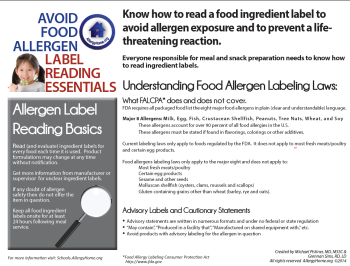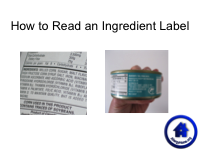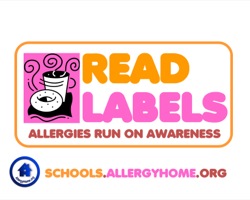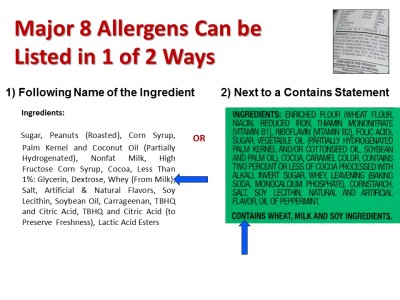Label Reading Handout, Module, and Posters
Know how to read a food ingredient label to avoid allergen exposure and to prevent a life-threatening reaction.
Created by Michael Pistiner, MD, MSSC &
Grennan Sims, RD, LD
Everyone responsible for meal and snack preparation needs to know how to read ingredient labels.
Allergen Label Reading Basics
- Read (and evaluate) ingredient labels for every food each time it is used. Product formulations may change at any time without notification.
- Get more information from manufacturer or supervisor for unclear ingredient labels.
- If any doubt of allergen safety then do not offer the item in question.
- Keep all food ingredient labels onsite for at least 24 hours following meal service.
Understanding Food Allergen Labeling Laws:
What FALCPA does and does not cover.
- FDA requires all packaged food list the eight major food allergens in plain (clear and understandable) language.
- Major 8 Allergens: Milk, Egg, Fish, Crustacean Shellfish, Peanuts, Tree Nuts, Wheat, and Soy
- These allergens account for over 90 percent of all food allergies in the U.S.
- These allergens must be stated if found in flavorings, colorings or other additives.
- Current labeling laws only apply to foods regulated by the FDA. It does not apply to most fresh meats/poultry and certain egg products.
- Food allergens labeling laws only apply to the major eight and does not apply to:
- Most fresh meats/poultly
- Certain egg products
- Sesame and other seeds
- Molluscan shellfish (oysters, clams, mussels and scallops)
- Gluten containing grains other than wheat (barley, rye and oats).
Advisory Labels and Cautionary Statements
Advisory statements are written in numerous formats and under no federal or state regulation
“May contain”, “Produced in a facility that”, “Manufactured on shared equipment with,” etc.
Avoid products with advisory labeling for the allergen in question
Looking at Ingredient Labels
Labels can list the 8 major food allergens in one of two ways:
Hidden Ingredients
Hidden ingredients are not an obvious part of a food. A person eating the food may have no idea that it contains an allergen.
Label reading is key to avoiding accidental ingestion of hidden ingredients!
If you can’t read it, then don’t eat (or serve) it!
Common Sources of Hidden Ingredients
Milk: Breads, caramel, hot dogs and deli meat, non-dairy creamers, cheese alternatives, canned tuna, guacamole, chocolate, butter substitutes, sauces…
Eggs: Mayonnaise, meringue, egg substitutes, cake mixes, frosting, pasta, salad dressing, meatballs, sauces, ice cream, glaze on soft pretzels…
Peanuts/Tree Nuts: Artificial and mixed nuts, desserts, ethnic cuisine, ice cream, barbeque and other sauces, marzipan, nougat, pesto, energy bars, granola, cereal, chocolate candies . . .
Fish/Shellfish: Worcestershire sauce, Caesar salad dressing, imitation crab products, Asian cuisine…
Wheat: All grain based products, processed foods, food starch, soy and other sauces…
Soy: Processed foods, breads, soups, sauces, canned meats, peanut butter, cereals, crackers…
Celiac Disease and Gluten Sensitivity
You may be caring for students with celiac disease or non- celiac gluten sensitivity. Celiac disease is a genetic autoimmune disease. Non-celiac gluten sensitivity is a condition that occurs in individuals who are unable to tolerate gluten and experience symptoms similar to those associated with celiac disease. Gluten is a protein found wheat, rye, and barley and their derivatives. Even though oats are inherently gluten-free, they are likely to be contaminated unless they are certified gluten-free. A small percentage of people with celiac disease do react to pure, uncontaminated oats. Accidental gluten exposure can cause severe gastrointestinal symptoms, brain fog, muscular pain and potentially long term health concerns.
Special Thanks to Our Reviewer: Beth Foland, MS RD, Team Nutrition Specialist, Indiana Department of Education, Office of School and Community Nutrition.



